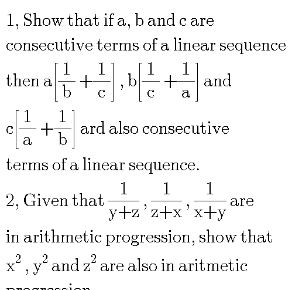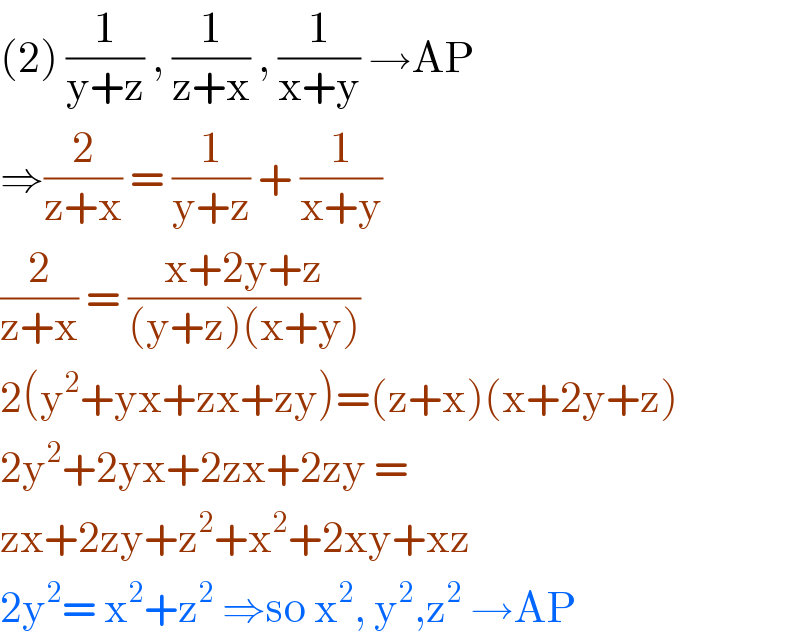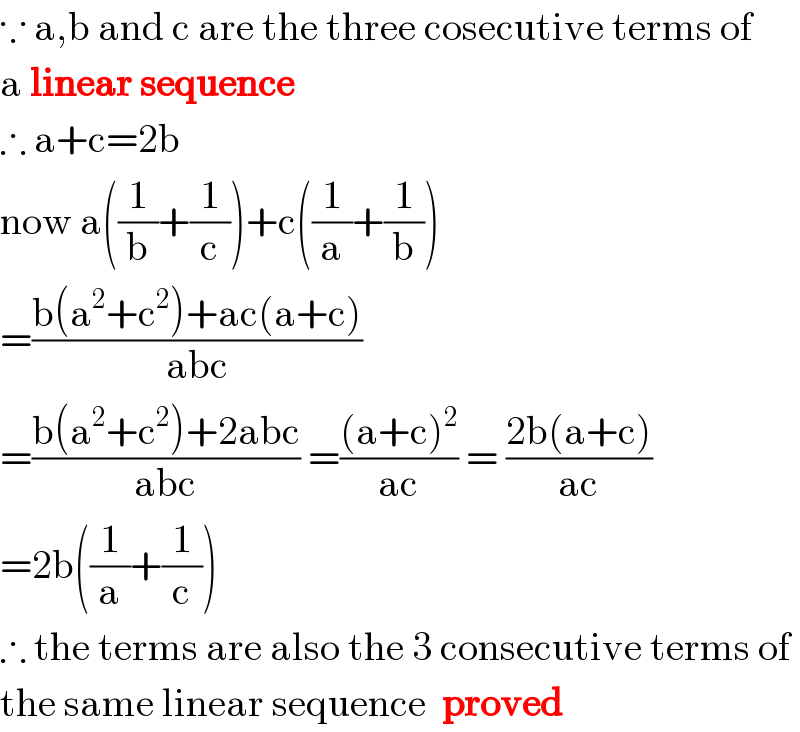Question Number 101563 by harckinwunmy last updated on 03/Jul/20

Answered by bramlex last updated on 03/Jul/20

$$\left(\mathrm{2}\right)\:\frac{\mathrm{1}}{\mathrm{y}+\mathrm{z}}\:,\:\frac{\mathrm{1}}{\mathrm{z}+\mathrm{x}}\:,\:\frac{\mathrm{1}}{\mathrm{x}+\mathrm{y}}\:\rightarrow\mathrm{AP} \\ $$$$\Rightarrow\frac{\mathrm{2}}{\mathrm{z}+\mathrm{x}}\:=\:\frac{\mathrm{1}}{\mathrm{y}+\mathrm{z}}\:+\:\frac{\mathrm{1}}{\mathrm{x}+\mathrm{y}} \\ $$$$\frac{\mathrm{2}}{\mathrm{z}+\mathrm{x}}\:=\:\frac{\mathrm{x}+\mathrm{2y}+\mathrm{z}}{\left(\mathrm{y}+\mathrm{z}\right)\left(\mathrm{x}+\mathrm{y}\right)} \\ $$$$\mathrm{2}\left(\mathrm{y}^{\mathrm{2}} +\mathrm{yx}+\mathrm{zx}+\mathrm{zy}\right)=\left(\mathrm{z}+\mathrm{x}\right)\left(\mathrm{x}+\mathrm{2y}+\mathrm{z}\right) \\ $$$$\mathrm{2y}^{\mathrm{2}} +\mathrm{2yx}+\mathrm{2zx}+\mathrm{2zy}\:= \\ $$$$\mathrm{zx}+\mathrm{2zy}+\mathrm{z}^{\mathrm{2}} +\mathrm{x}^{\mathrm{2}} +\mathrm{2xy}+\mathrm{xz} \\ $$$$\mathrm{2y}^{\mathrm{2}} =\:\mathrm{x}^{\mathrm{2}} +\mathrm{z}^{\mathrm{2}} \:\Rightarrow\mathrm{so}\:\mathrm{x}^{\mathrm{2}} ,\:\mathrm{y}^{\mathrm{2}} ,\mathrm{z}^{\mathrm{2}} \:\rightarrow\mathrm{AP} \\ $$
Answered by PRITHWISH SEN 2 last updated on 03/Jul/20

$$\because\:\mathrm{a},\mathrm{b}\:\mathrm{and}\:\mathrm{c}\:\mathrm{are}\:\mathrm{the}\:\mathrm{three}\:\mathrm{cosecutive}\:\mathrm{terms}\:\mathrm{of} \\ $$$$\mathrm{a}\:\boldsymbol{\mathrm{linear}}\:\boldsymbol{\mathrm{sequence}} \\ $$$$\therefore\:\mathrm{a}+\mathrm{c}=\mathrm{2b} \\ $$$$\mathrm{now}\:\mathrm{a}\left(\frac{\mathrm{1}}{\mathrm{b}}+\frac{\mathrm{1}}{\mathrm{c}}\right)+\mathrm{c}\left(\frac{\mathrm{1}}{\mathrm{a}}+\frac{\mathrm{1}}{\mathrm{b}}\right) \\ $$$$=\frac{\mathrm{b}\left(\mathrm{a}^{\mathrm{2}} +\mathrm{c}^{\mathrm{2}} \right)+\mathrm{ac}\left(\mathrm{a}+\mathrm{c}\right)}{\mathrm{abc}} \\ $$$$=\frac{\mathrm{b}\left(\mathrm{a}^{\mathrm{2}} +\mathrm{c}^{\mathrm{2}} \right)+\mathrm{2abc}}{\mathrm{abc}}\:=\frac{\left(\mathrm{a}+\mathrm{c}\right)^{\mathrm{2}} }{\mathrm{ac}}\:=\:\frac{\mathrm{2b}\left(\mathrm{a}+\mathrm{c}\right)}{\mathrm{ac}} \\ $$$$=\mathrm{2b}\left(\frac{\mathrm{1}}{\mathrm{a}}+\frac{\mathrm{1}}{\mathrm{c}}\right) \\ $$$$\therefore\:\mathrm{the}\:\mathrm{terms}\:\mathrm{are}\:\mathrm{also}\:\mathrm{the}\:\mathrm{3}\:\mathrm{consecutive}\:\mathrm{terms}\:\mathrm{of} \\ $$$$\mathrm{the}\:\mathrm{same}\:\mathrm{linear}\:\mathrm{sequence}\:\:\boldsymbol{\mathrm{proved}} \\ $$
